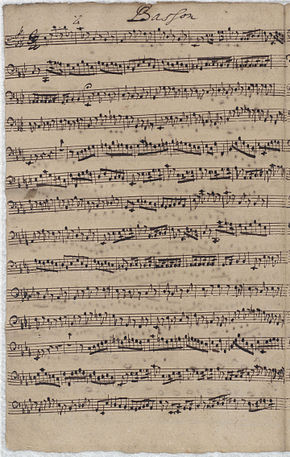Wachet auf, ruft uns die Stimme, BWV 140
| Wachet auf, ruft uns die Stimme | |
|---|---|
| BWV 140 | |
| Chorale cantata by J. S. Bach | |

The first page of the bassoon part in Bach's hand from the archives of the Thomaskirche, one of few surviving instrumental parts written by him
|
|
| Known as | Sleepers Wake |
| Occasion | 27th Sunday after Trinity |
| Performed | 25 November 1731: Leipzig |
| Movements | 7 |
| Cantata text | anonymous |
| Chorale | "Wachet auf, ruft uns die Stimme" by Philipp Nicolai |
| Vocal |
|
| Instrumental |
|
Wachet auf, ruft uns die Stimme (Awake, calls the voice to us),BWV 140, also known as Sleepers Wake, is a church cantata by Johann Sebastian Bach, regarded as one of his most mature and popular sacred cantatas. He composed the chorale cantata in Leipzig for the 27th Sunday after Trinity and first performed it on 25 November 1731.
Bach composed this cantata to complete his second annual cycle of chorale cantatas, begun in 1724. The cantata is based on the hymn in three stanzas "Wachet auf, ruft uns die Stimme" (1599) by Philipp Nicolai, which covers the prescribed reading for the Sunday, the parable of the Ten Virgins. The text and tune of the hymn appears unchanged in movements 1, 4 and 7. An unknown author supplied poetry for the inner movements as sequences of recitative and duet, based on the love poetry of the Song of Songs. Bach structured the cantata in seven movements, setting the first stanza as a chorale fantasia, the second (movement 4) in the style of a chorale prelude, and the third as a four-part chorale. He set the new texts as dramatic recitatives and love-duets, similar to contemporary opera. Bach scored the work for three vocal soloists (soprano, tenor, bass), a four-part choir and a Baroque instrumental ensemble of horn (to enforce the soprano), two oboes, taille, violino piccolo, strings and basso continuo including bassoon.
...
Wikipedia
